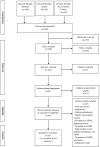Gestational diabetes mellitus in Africa: a systematic review
- PMID: 24892280
- PMCID: PMC4043667
- DOI: 10.1371/journal.pone.0097871
Gestational diabetes mellitus in Africa: a systematic review
Abstract
Background: Gestational diabetes mellitus (GDM) is any degree of impaired glucose tolerance first recognised during pregnancy. Most women with GDM revert to normal glucose metabolism after delivery of their babies; however, they are at risk of developing type 2 diabetes later in life as are their offspring. Determining a country's GDM prevalence can assist with policy guidelines regarding GDM screening and management, and can highlight areas requiring research. This systematic review assesses GDM prevalence in Africa.
Methods and findings: Three electronic databases were searched without language restrictions; PubMed, Scopus and the Cochrane Library. Thirty-one search terms were searched. Eligible articles defined GDM, stated what GDM screening approaches were employed and reported GDM prevalence. The reporting quality and risk of bias within each study was assessed. The PRISMA guidelines for systematic reviews were followed. The literature search identified 466 unique records. Sixty full text articles were reviewed of which 14 were included in the systematic review. One abstract, for which the full text article could not be obtained, was also included. Information regarding GDM classification, screening methods and prevalence was obtained for six African countries; Ethiopia (n = 1), Morocco (n = 1), Mozambique (n = 1), Nigeria (n = 6), South Africa (n= 4) and Tanzania (n = 1). Prevalence figures ranged from 0% (Tanzania) to 13.9% (Nigeria) with some studies focussing on women with GDM risk factors. Most studies utilised the two hour 75 g oral glucose tolerance test and applied the World Health Organization's diagnostic criteria.
Conclusions: Six countries, equating to 11% of the African continent, were represented in this systematic review. This indicates how little is known about GDM in Africa and highlights the need for further research. Considering the increasing public health burden of obesity and type 2 diabetes, it is essential that the extent of GDM is understood in Africa to allow for effective intervention programmes.
Conflict of interest statement
Figures
References
-
- Sierra GN (2009) The global pandemic of diabetes: an update. Africa Health 32: 50–54.
-
- Yogev Y, Metzger BE, Hod M (2009) Establishing diagnosis of gestational diabetes mellitus: Impact of the hyperglycemia and adverse pregnancy outcome study. Semin Fetal Neonatal Med 14: 94–100. - PubMed
-
- World Health Organization (2002) Laboratory diagnosis and monitoring of diabetes mellitus. Geneva: World Health Organization.
-
- World Health Organization (1999) Definition, diagnosis and classification of diabetes mellitus and its complications. Report of a WHO consultation. Part 1: Diagnosis and classification of diabetes mellitus. Geneva: World Health Organization.
-
- American Diabetes Association (2014) Standards of medical care in diabetes–2014. Diabetes Care 37 Suppl 1S14–80. - PubMed
Publication types
MeSH terms
Grants and funding
LinkOut - more resources
Full Text Sources
Other Literature Sources


